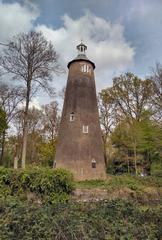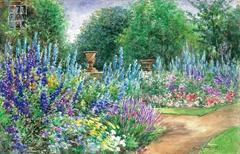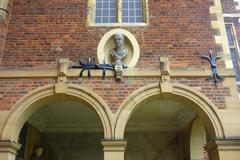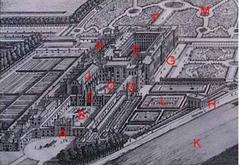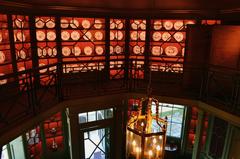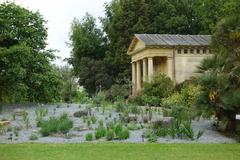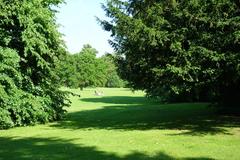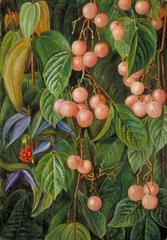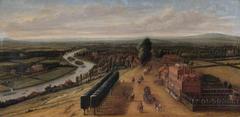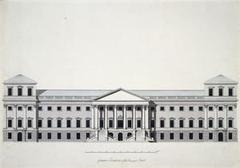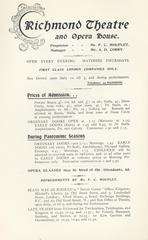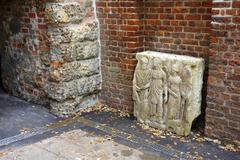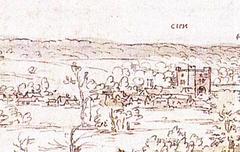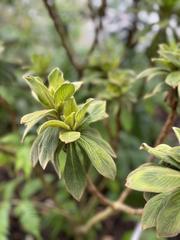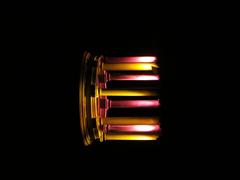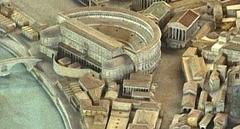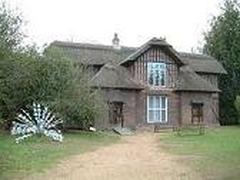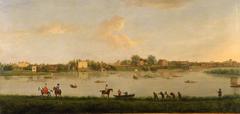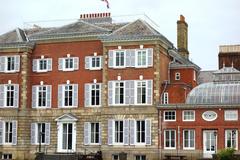The Hive at Kew Gardens, Richmond, UK: Visiting Hours, Tickets, and Essential Guide
Date: 14/06/2025
Introduction
Nestled within the renowned Royal Botanic Gardens in Richmond, London, The Hive stands as a spectacular fusion of art, science, and environmental education. This 17-meter-tall aluminium structure, originally designed by Wolfgang Buttress for the 2015 Milan Expo, now serves as a permanent, award-winning installation at Kew Gardens. The Hive offers visitors a multisensory journey, highlighting the vital role of honeybees in our ecosystem through immersive light and sound experiences, all driven by the real-time activity of a nearby bee colony (ArchDaily; Wikipedia; Creative Boom). This comprehensive guide covers The Hive’s origins, design, visitor information, accessibility, nearby attractions, and tips for a memorable visit.
The Hive: Origins and Concept
From Milan to London
The Hive was originally unveiled as the United Kingdom’s pavilion at the 2015 Milan Expo, attracting over 3.3 million visitors and earning a Gold Medal for its innovative design and ecological message (ArchDaily). The concept, by artist Wolfgang Buttress, was developed in collaboration with scientists and engineers to immerse guests in the intricate world of bees, highlighting their essential role as pollinators and the threats they face from environmental changes, pesticides, and disease.
Following its success, The Hive was meticulously dismantled, transported, and reassembled at Kew Gardens, opening to the public in June 2016. Its new home within a wildflower meadow at Kew reinforces its ecological theme, providing a living habitat for pollinators (Wikipedia).
Architecture, Artistry, and Innovation
Structural Composition
The Hive’s design draws inspiration from the geometry of honeycomb, comprising approximately 169,000 aluminium pieces assembled into a 17-meter-tall lattice structure weighing 40 tonnes (ArchDaily; Garden Travel Guide). Its open, hexagonal configuration creates a striking visual and tactile experience, allowing sunlight to filter through and providing a sense of immersion.
Multisensory Experience
Embedded within The Hive are nearly 1,000 LED lights and a responsive soundscape, both linked to sensors monitoring the vibrations of a real bee colony elsewhere in the gardens. These accelerometers capture the bees’ activity and translate it into dynamic light and sound patterns, including orchestral music composed in collaboration with Buttress’s daughter Camille and music groups such as Spiritualized and Amiina. The resulting environment fluctuates in real time, ensuring every visit is unique (Creative Boom; Worley Gig).
Symbolism
The Hive not only mimics the structure of a beehive but also serves as a powerful metaphor for the interconnectedness of natural systems and the fragility of pollinator populations. Its transparent, open form invites contemplation of the delicate balance sustaining both bees and people (ArchDaily).
Scientific Collaboration and Educational Mission
The Hive’s interactive features are rooted in scientific research, particularly the study of bee communication by Dr. Martin Bencsik at Nottingham Trent University. By making the hidden world of bees visible and audible, the installation educates visitors about pollinator biology and the urgent need for conservation (Kew Gardens London). The wildflower meadow surrounding The Hive further demonstrates best practices in supporting biodiversity and pollinator health (Wildflower Turf case study).
Visitor Information
Location and How to Get There
- Address: Royal Botanic Gardens, Kew, Richmond, London, TW9 3AE (Kew Gardens: The Hive)
- Nearest Gate: Elizabeth Gate (closest to The Hive)
- By Tube: Kew Gardens Station (District Line and London Overground), ~500m from Victoria Gate (Strawberry Tours)
- By Train: Kew Bridge Station, ~800m from Elizabeth Gate
- By Bus: Routes 65, 110, 237, and 267 serve the area
- By Car: Car park at Brentford Gate (£9/day), closes 30 minutes before garden closing (Kew Gardens FAQ)
Visiting Hours
- Kew Gardens: Open daily from 10:00 am, closing times vary by season:
- Summer: 7:00–8:00 pm
- Autumn: 6:00–7:00 pm
- Winter: as early as 3:15 pm (Kew Gardens FAQ)
- The Hive: Open during general Kew Gardens hours. Early visits are recommended for a quieter experience (The World in My Pocket).
Tickets and Entry
- Ticket Prices: Adults £20–£22; children under 4 free; concessions and family tickets available (Strawberry Tours)
- What’s Included: Admission to The Hive, all glasshouses, galleries, and guided walking tours (Kew Gardens FAQ)
- Booking: Online purchase recommended, especially during peak seasons
- Cancellations: Flexible options until 23:59 the day before your visit
Accessibility
- Paths: Largely flat, paved, suitable for wheelchairs and strollers
- Mobility Aids: Wheelchairs and mobility scooters available for hire (advance booking advised)
- Assistance Dogs: Only registered assistance dogs permitted
- Accessible Facilities: Toilets and accessible parking available; accessibility maps at entrances
The Hive Visitor Experience
- Immersive Structure: 17 meters tall, made of 170,000 aluminium parts and 1,000 LED lights (Kew Gardens: The Hive)
- Sensory Features: Real-time light and soundscapes triggered by the activity of a nearby bee colony (CNN Style)
- Photography: Highly photogenic, especially at dusk; drones prohibited
- Family Friendly: Engaging for children, with interactive displays and educational value (Candace Abroad)
Facilities and Amenities
- Cafés and Restaurants: Choices include the Orangery, Botanical Brasserie, Pavilion Bar and Grill, and Family Kitchen (Time Travel Turtle)
- Restrooms: Located throughout the gardens, including near The Hive
- Picnic Areas: Designated spots in the Rose Garden, Arboretum, and Cedar Vista
- Shops: Gift shops near entrances offer bee-themed souvenirs and Kew Gardens honey (The Foodie Travel Guide)
Practical Tips for Your Visit
- Arrive Early: To beat crowds, visit between 10:00 and 11:00 am (Strawberry Tours)
- Comfort: Wear comfortable shoes and bring weather-appropriate clothing (Candace Abroad)
- Essentials: Bring water, snacks, and a portable charger; check event calendars for special activities
- Rules: No bicycles, scooters, skateboards, or drones; respect the plantings and wildlife (Kew Gardens FAQ)
Special Events and Educational Programs
- Hive Lates: Evening events with illuminated displays and special soundscapes in September (e-architect)
- Guided Tours: Free walking tours twice daily, covering The Hive and other highlights
- Workshops: Talks and educational activities about pollinators, especially during school holidays
Nearby Attractions at Kew Gardens
- Palm House: Iconic Victorian glasshouse with tropical plants
- Temperate House: The world’s largest Victorian glasshouse
- Princess of Wales Conservatory: 10 climate zones under one roof
- Treetop Walkway: Panoramic views of the gardens
- Japanese Pagoda and Rose Garden: Ideal for a full-day exploration (Justyn Jen)
Frequently Asked Questions (FAQ)
Q: Is a separate ticket required for The Hive?
A: No, entry is included with your general Kew Gardens admission ticket.
Q: Are pets allowed in Kew Gardens?
A: Only registered assistance dogs are permitted.
Q: Is The Hive suitable for children and wheelchair users?
A: Yes, The Hive is family-friendly and wheelchair accessible.
Q: When is the best time to visit?
A: Early mornings and weekdays are quieter; dusk offers dramatic lighting for photography.
Q: Are guided tours available?
A: Yes, free guided walking tours are run twice daily.
Summary and Final Tips
The Hive at Kew Gardens represents a unique intersection of art, science, and environmental stewardship. Through its innovative design and real-time sensory features, it raises awareness of pollinator conservation while offering an unforgettable visitor experience. Its accessible location, comprehensive facilities, and engaging educational programs make it a must-visit attraction for all ages.
To maximize your visit:
- Check the official Kew Gardens website for updated hours and ticket information.
- Download the Audiala app for audio-guided tours and interactive experiences.
- Explore nearby attractions within the gardens for a full day of discovery.
The Hive not only celebrates the beauty and importance of bees but also inspires visitors to take action for the future of biodiversity.
Sources
- ArchDaily
- Wikipedia
- Creative Boom
- Kew Gardens London
- Strawberry Tours
- Garden Travel Guide
- Worley Gig
- Kew Gardens: The Hive
- Kew Gardens FAQ
- The World in My Pocket
- e-architect
- Time Travel Turtle
- Candace Abroad
- The Foodie Travel Guide
- Justyn Jen
- Wildflower Turf case study
- CNN Style
